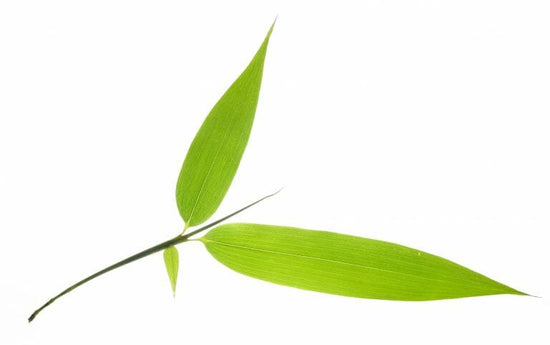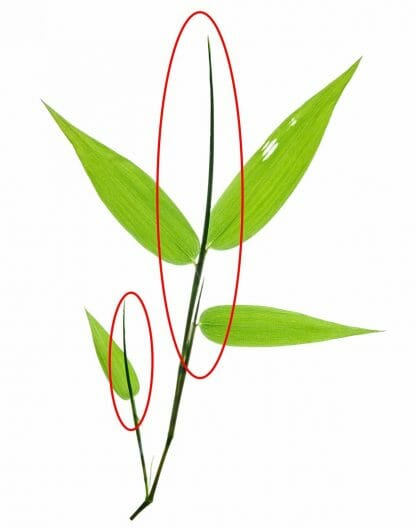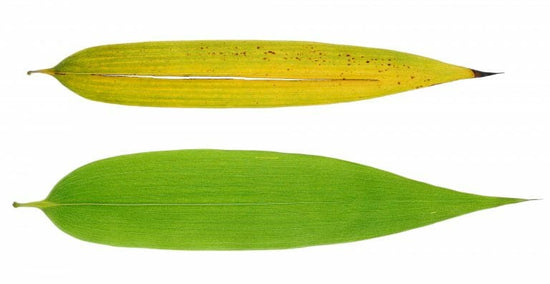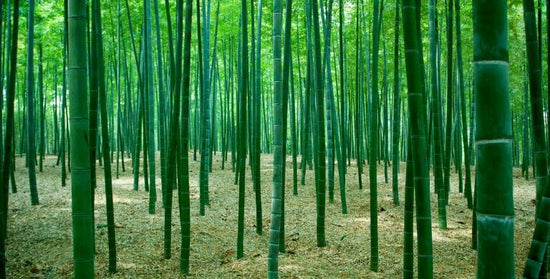Bamboo Leaves
Leaf Characteristics
Bamboo is a perennial evergreen plant with annual leaf exchange. New leaves emerge in the springtime to gently push off old foliage. These yearly foliage cycles allow for bamboo to provide natural privacy in all seasons of the year. Bamboo in the appropriate climate should never be without foliage.

Leaf Life Cycle
The new foliage or leaflet (Figure 2 circled in red) emerges similar to a small shoot behind the existing foliage in the Spring. This small spike expands to the length of a leaf and it gently unrolls. during the end of this process, the existing foliage is dropped by the plant. The exchange is gradual and can go unnoticed unless a close inspection is performed.

The leaf experiences natural aging during the yearly leaf cycle. Soil conditions, species, and weather can cause the foliage to present in slightly different shades of color too. Leaves at the end of the cycles become more prone to bacterial, fungal and even plant scale infections. These are natural occurrences and mechanisms in most all environments that are attracted to flora in later stages of life cycles and typically does not transfer to the new foliage.

Figure 3 shows leaves in different stages of the life cycle. The top leaf represents foliage that is ready to be replaced. It has become absent of chlorophyll, slightly desiccated and cracked by the wind, and has a little plant rust. Once again, this is a normal experience at the end of the foliage life cycle. The lower picture is of newly formed foliage unaffected by any of the aforementioned ailments.

Once the old foliage has dropped, it is best to leave it on the groves. The leaves serve multiple beneficial purposes for the bamboo groves. The leaves are high in silica and bamboo thrives on silica. Bamboo leaves are like a natural fertilizer that helps the plant’s growth in future years. Leaf decomposition and nutrient release typically occur in one year following the foliage drop. The foliage is also beneficial in suppressing competitive growth. It also presents in a beautiful mat on the forest floor.
Bamboo Leaf Size
Most bamboo foliage is small and delicate. Typical bamboo foliage, at least the foliage (Figure 1) of the Phyllostachys genus, ranging from around 3 to 6 inches long and .5 to .75 inches wide.
The Phyllostachys is the most common type of temperate bamboo and is the most widely recognized bamboo. This being stated, there are over 1400 species of bamboo in the world with various leaf sizes. Some like the Indocalamus Tessellatus can produce a leaf that measures 26 inches long by 5 inches wide.
Bamboo Leaf Uses
Bamboo leaves are high in fiber, protein, and silica, resulting in many use cases. Some current and potential uses are:
- Bamboo Tea
- Bamboo Beer
- Livestock Feed
- Medicinal Aids
- Aromatherapy
- Essential Oils
Bamboo foliage is fairly high in protein. Some species have been found to contain up to 22% protein, making bamboo a good source of livestock feed. Current bamboo industrial and consumer products focus on bamboo culms. The tops and foliage of this amazing plant are often overlooked. Advancement in the utilization of bamboo culms presents opportunities for the remaining foliage to be captured for livestock foliage since it is exceeding high in protein. Horses have even been observed pushing and bending a cane down to eat the foliage. The chart below demonstrates the protein content in comparison with typically used feedstocks.
Silica in Bamboo
Bamboo foliage is also high in silica. Bamboo is known as one of the highest organic sources of silica. In studies, the dry weight silicon was over 7% by gravimetric quantification. The leaf extract is also promoted as a rich source of active compounds, like flavonoids, phenolic, and amino acid, lactone, antioxidants, and micro-elements. These are emerging industries so much testing and standardization is ongoing to make bamboo leaves a more accepted and controlled ingredient. Bamboo foliage is currently be used in making bamboo beer, bamboo tea, and medicinal aids.
